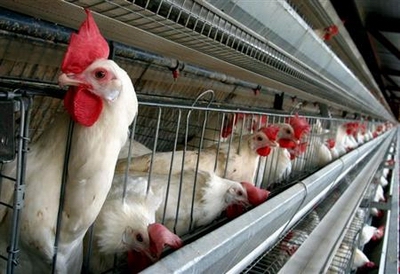
U.S. agriculture regulators pushing to overhaul food safety inspections at poultry slaughterhouses have not thoroughly evaluated several pilot projects, which critics have said could jeopardize food safety, according to a report released by the U.S. Government Accountability Office on Wednesday.
The GAO report also said the U.S. Department of Agriculture failed to disclose accurate information about the data the department used to promote what it calls "modernization" changes at the plants.
Meat and poultry products contaminated with dangerous pathogens such as salmonella cause many food borne illnesses, and the government plan, which includes speeding up processing lines while cutting back on the number of government inspectors, has sparked significant opposition.
If the government is to actually improve poultry inspection, "the Obama Administration needs to get the legal authority from Congress to hold companies accountable for putting contaminated food into commerce, not deregulate inspection," said Wenonah Hauter, executive director of Food & Water Watch, in a statement issued on Wednesday. Food & Water Watch has been a leading critic of the government plans.
But the USDA's Food Safety Inspection Service, or FSIS, said there are several inaccuracies contained in the GAO report. It added that the findings miss the main objective of the government effort, which is to reduce overlapping inspections by plant employees and government inspectors and allow government inspectors to focus on areas of greatest risk to food safety.
Chickens, Turkeys and Hogs
The USDA has been overseeing a pilot project at slaughter plants for young chickens, turkeys and hogs since 1998 with a goal of reducing the number of federal inspectors to save taxpayer money while still strengthening the inspection of carcasses for food safety concerns.
As of July, 29 plants were participating - 19 chicken slaughter plants; 5 turkey plants and 5 hog plants.
In 2011, the USDA said operation of the pilot project at 20 young chicken plants showed that the streamlined inspection program would ensure equivalent, if not better, levels of food safety and quality than currently provided at plants not in the pilot project. In early 2012, the USDA published a proposed rule that would extend the pilot program for poultry to all U.S. poultry plants.
But the GAO report said it found that the USDA relied on limited snapshots of data from two two-year periods, rather than from the duration of the entire pilot project. In addition, the USDA did not complete any evaluation for the pilot projects at five young turkey plants, yet when it published a proposed rule that included an optional new inspection system for both chicken and turkey plants, the USDA stated that it was relying on experience with both chicken and turkey plants.
The USDA is similarly limiting its evaluation of data from hog plants as it prepares a rule to govern inspections at those slaughterhouses, the GAO said.
The GAO report was requested by Sen. Kirsten Gillibrand, a Democrat from New York, after several food and environmental groups expressed concerns about the pilot programs.
The senator sent a letter on Wednesday to the Office of Management and Budget urging it to ensure that the new rule for modifying poultry inspection does not go forward "until further action is taken to protect food safety." The letter was made available to Reuters by Gillibrand's office.
The GAO report, Sen. Gillibrand said, shows that the FSIS' evaluation of the pilot program is "deeply flawed" and "not formulated on a strong scientific basis."
Under the USDA proposal to expand the pilot projects, plants could dramatically speed up processing lines and replace many USDA inspectors with poultry company employees. For decades, government poultry inspectors have been stationed along processing lines to identify contaminated and diseased carcasses.
Critics fear that when plants speed up their processing and cut back on government inspectors, poultry feces and signs of disease on the birds are more likely to go undetected before the poultry is processed into food products.
But government officials have said poultry will actually be safer in the new system, which would be the first major overhaul of poultry inspection in 50 years. Proponents say the current system requires government inspectors to spend time looking for defects that are quality related but not necessarily safety related. The new system would allow government inspectors to spend more time focused on microbiological testing and other food safety activities, the proponents say.
In the new system, plant operators would be responsible for sorting animal carcasses themselves and would be required to develop procedures to make sure poultry that could be dangerous for human consumption is identified. A USDA inspector would remain at the end of each slaughter line at each poultry plant and at three fixed locations on the slaughter line at each hog plant to conduct a carcass-by-carcass inspection after plant personnel have completed sorting.
Tyson Foods Inc., one of the world's largest poultry companies, has been piloting the plan at some of its poultry plants and has been a supporter of the changes.





